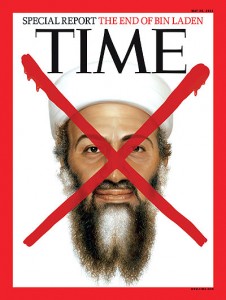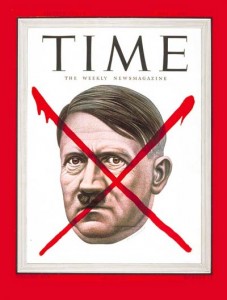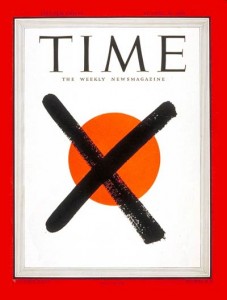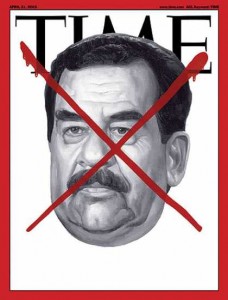Time magazine made an obvious and unimaginative choice for its cover last week, showing an image of Osama bin Laden with a dripping red X across his face.
The Osama cover, by illustrator Tim O’Brien, is an homage to the magazine’ May 7, 1945, Page One commemorating the death of Adolph Hitler, but with a small but notable difference. The Hitler cover was entirely uncaptioned – the image said it all. For today’s audience (current print circulation 3.3 million), Time’s editors felt the need to note that inside readers would find a special report on “The End of Bin Laden.”
It’s certainly appropriate for Time to adapt the Hitler image for bin Laden’s death. Despite his comparatively miniscule dark accomplishments, the Al Qaeda leader loomed as large in the contemporary American imagination as Hitler did in the 1940s, when millions of American men were under arms, hundreds of thousands were dying on the battlefield, and the entire nation lived on a war footing.
But this isn’t the first occasion that Time has used the Hitler-is-Dead format. Time’s June 19, 2006, cover marking the death of Abu Mousab al Zarqawi, the hyper-violent leader of Al Qaeda in Iraq, following his liquidation by a pair of 500-pound American bombs. For that week’s edition, editors followed more closely their 1945 model. Zarqawi was depicted without caption under the blood red X.
The problem was that almost no one in the United States or around the world (the cover ran on all of Time’s international editions, with the exception of Asia) knew – or cared — what Abu Mousab al Zarqawi looked like. Zarqawi wasn’t a household name, and, despite his record of cruelty, his shadow didn’t extend beyond Iraq and Jordan. The image was generic: Generic Arab.
I was living in Cairo when Zarqawi was killed (Jay Carney, who today is President Obama’s press secretary, wrote Time’s lead story). When I looked at the red X cover, I saw not a murderous extremist with buckets of blood on his hands, but a man who looked much like any number of young, devout Arabs who held religious views quite different from my own, but who would sooner drown in the Nile or the Euphrates than do me or any other person harm over those differences.
This week’s Osama cover rings true for its specificity, for herald of welcome news, for the superfluity of words inherent to the image. The 2006 attempt at profundity rang more as a broad and lazy defamation.
* * * * *
Since first writing this I’ve learned Time in fact published two other triumphal X covers. This one, marking the atomic bomb attacks on Hiroshima and Nagasaki, marks with grim pride the close of the grinding Pacific war and the end of World War II. Whether you agree with Truman’s decision to unleash the atom on these two cities, the Time cover is an accurate illustration of America’s cold satisfaction that no more of its soldiers would die fighting the Imperial army. Three weeks later, Japan formally, and unconditionally, surrendered.
Contrast the V-J cover with this image of Saddam Hussein. This cover, from April 21, 2003, marks the end of his rule as American forces took Baghdad. The Butcher of Baghdad survived the initial invasion; he would die years later, hanged in front of his lifelong Shiite enemies, who taunted and shrieked at him as the trap door fell. This cover, in its use of the red X, is visually arresting, but seems both a stretch and a fib: Saddam Hussein wasn’t an existential threat to the United States, and he didn’t die at American hands. He was out of the way, but the insurgency he helped plan would go on to take many thousands of civilian and American military lives.
So who’s next for the big red X? This powerful icon works best when its subject approaches, in fact or in perception, the evil potential of its first recipient.





